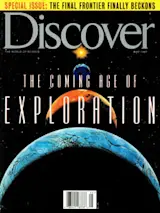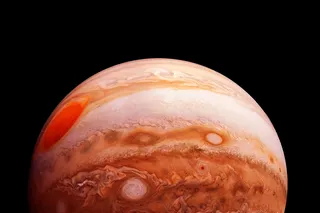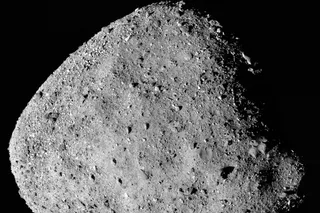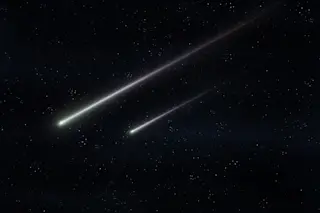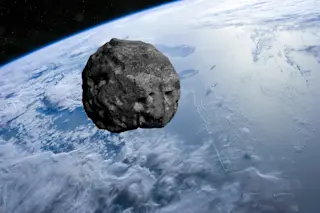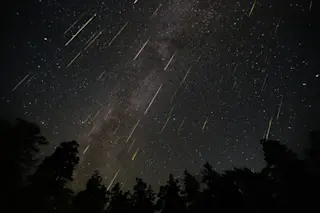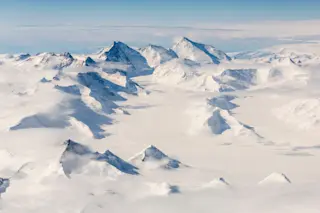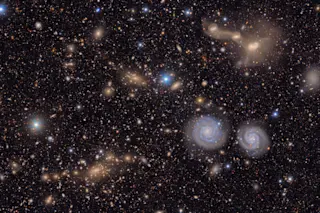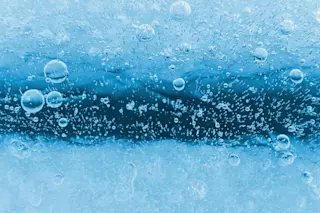Ralph Harvey holds a shooting star in his mitten. It’s a meteorite, a piece of outer space some 4.5 billion years old. This rock has seen the infancy of the solar system, the extinction of the dinosaurs, the birth of Dick Clark. Meteorites are without rival the oldest things on Earth. To gaze upon this rock, you cannot help feeling a sense of awe. You might feel other things as well, if only you weren’t numb from riding around on a Ski-doo in a -40 degree windchill for the past three hours.
Meteorite hunting is not for wimps. The best places to look are also the coldest and windiest. You need very old ice, and you need wind, lots of it, strong and unrelenting. Antarctica fits the bill. This year, the Antarctic Search for Meteorites (ANSMET) has set up camp out beyond the Transantarctic Mountains, smack dab nowhere on something called the East Antarctic Ice Sheet. It’s not that more meteorites fall in polar regions. (Earth gets an evenly distributed smattering--about one meteorite falls to the ground every two days.) It’s that they keep better here and are easier to spot. The Barbados Search for Meteorites would be pleasanter but ultimately fruitless.
Here is what happens: Meteorites that fall on Antarctica are buried beneath snow that is in turn buried under more snow until the pressure of the weight turns it to ice. This ice, with its chocolate-chip load of meteorites, makes its way slowly, on the order of about ten feet a year, downhill toward the fringes of the continent, where it eventually calves off into the sea. Unless a mountain range gets in its way. In which case the ice collides with the mountains and, like water against a cliff, surges upward, albeit infinitesimally. Enter the wind. A cold, dense katabatic wind rolls down from the top of the gently sloping plateau. It clears the snow off the ice and powers a battalion of airborne ice crystals that scour away at the surface ice, wearing it down so that the meteorites trapped within are gradually exposed. One by one, a hundred millennia’s worth of meteorites appear at the surface.
One by one, Harvey and his colleagues find them (including ALH84001, the famed Life on Mars meteorite, found by 1984 ANSMET member Roberta Score).This season’s tally is 374, including the 15 found so far this afternoon. Meteorite hunting is a one-of-a-kind pursuit, combining the systematic precision of a crime-scene search for evidence with the giddy anticipation of an Easter-egg hunt. The six team members ride on snowmobiles 50 feet apart, moving slowly forward in a line while scanning the ice around them. When they reach the perimeter of the area they’re searching, they turn around, line up on the next strip of ice, and go back the other way.
While it is wind that allows them to do what they do, it is also wind that gets in their way. When the gusts top 20 miles an hour, blowing snow obscures the ice, and not even expedition-weight thermal underwear and Darth Vader-style face shields (actually motocross masks) can keep out the chill. The team spent ten straight days tent-bound during its first month. War and Peace made the rounds. We thought about strip poker, deadpans Harvey. But it’d take us four days to get through all the layers. Harvey speaks out of one side of his mouth, every now and then switching sides like a sailor shifting ballast in a storm. At 36, he is younger than you expect a Ralph to be. This is his eighth season on the ice; he took over the grant from his former adviser, meteoriticist Bill Cassidy, who founded ansmet in 1976. When he’s not stalking space rocks in Antarctica, Harvey is hunkering down in Cleveland, where he teaches at Case Western Reserve University and does research on the rocks he and others have found.
ANSMET’s other nemesis is the crevasse. Mountain ranges have an unkind tendency to rend deep, deadly cracks in ice sheets, the sort of cracks that swallow up entire snowmobiles. The U.S. Antarctic Program Field Manual outlines options should a snowmobile start to break through snow above a crevasse: Experience and circumstance will dictate whether to brake . . . or continue driving forward in hopes of getting across. . . . In either case, a change of underwear is recommended.
This year’s ice field sits far enough back from the mountains to be free of crevasses. The ice is pale blue and its surface rises and dips in shallow swells, giving it the appearance of a vast frozen sea. Most of the snow is blown away. What remains is carved by the wind into meringue- stiff fingers of snow called sastrugi, which marble the blue. There are days when sky and cloud so closely mirror ice and snow that the horizon is anyone’s guess.
It is an otherworldly place, so much so that the occasional meteorites sitting on the ice seem in comparison familiar-looking sights. With their blackened fusion crust--burn scars from the hot air compressed in front of them as they plummet through our atmosphere--they look less like space rocks than charcoal briquettes. It’s as though someone emptied a Weber from 30,000 feet.
Team member Rene Martinez has stopped his Ski-doo and is waving his arms over his head. This is ansmet semaphore for Hey, over here! I found one! Meteorites are easy to spot, as there’s absolutely nothing else on the ice, save the occasional scrap of snowmobile tread. This was not always the case. Few years back we had a guy who loved prunes and spit out the pits, says Harvey. Gave us no end of trouble for years and years.
The rest of the team motors over to see what Martinez has found. Harvey’s Ski-doo is equipped with a Global Positioning Satellite feed, which calculates the latitude and longitude of each meteorite, so records can be kept and maps made. The meteorite is then measured, tagged, bagged, sealed, and brought back to camp. No analysis is done in the field; the rocks are simply stored in a locked wooden box on a sled outside Harvey’s tent. One sled holds the expedition’s most treasured things: meteorites, Bailey’s Irish Cream, and toilet paper.
At the close of the field season, the meteorites are shipped to the meteorite processing lab at the NASA Johnson Space Center in Houston. Twice a year, a catalog describing the available specimens is sent to researchers around the world, who may then request a piece of any rock. (No one gets an entire meteorite. More than 60 research groups, for example, have pieces of the famed alh84001.)
The meteorite at Martinez’s feet is a chondrite, a chunk of wayward asteroid that fell under the sway of Earth’s gravitational field. Chondrites are the pigeons of the meteorite kingdom, making up some 90 percent of the ansmet harvest. All other meteorites are achondrites: volcanic rocks from planets or asteroids large enough to have a molten core.
Chondrites are common but hardly ordinary. They are bits and pieces of early asteroids, the first things to coalesce from the cloud of gas and dust that ultimately became our solar system. Radioactive dating techniques have placed these humble stones at 4.5 billion years. The uniformity of that number is amazing, says Harvey. They may vary 100 million years here or there, but no chondrites are 3 or 5 billion years old.
Their age makes them peers of the sun. In fact, the spectroscopic profile of the sun is identical to that of most chondrites--minus gases like hydrogen and helium that escape the gravity of a small body. When you’ve got a chondrite in your hand, intones Harvey, you are holding a piece of the sun. His words are heavy with scientific reverence; however, it’s difficult to share the solemnity of the moment, given that the man has toy reindeer antlers strapped to his head. (Christmas is two days away.)
Taken together, chondrites’ similarity to the sun and their vast age serve to verify a key astronomical notion: that the sun and the solar system had the same origin. Which isn’t a point that a lot of people would have grasped 100 years ago, Harvey adds.
For meteoriticists, chondrites are a sort of handheld time machine. By looking at them we can learn things about the early solar system, such as when it formed, and what it was made of, and what sort of processes were going on at that time, says ansmet member Sara Russell, who studies chondrites at the Smithsonian Institution mineral sciences department. A chondrite is actually an agglomeration of many specks, called chondrules, that formed in the solar system’s infancy and then over the millennia were drawn together by gravity. By breaking off these individual grains and dating them, Russell can estimate how long it took the solar system to form. She does so by measuring the concentration of aluminum 26, a radioactive isotope that was present in abundance at the formation of the solar system. Bodies that formed very early contain aluminum 26; those that formed a few million years later largely do not, since by then most of the aluminum 26 had decayed into magnesium 26. By measuring the relative amounts of the two isotopes, you can work out how long it took a chondrite- -and, by extension, the solar system--to form.
By Russell’s figuring, it took at least 5 million years to go from dust cloud to planetary system--a span considerably longer than that generated by theoretical models, which typically set the period at less than a million years. The models are based on the premise that once you form little bitty things, you have to form planets immediately, because otherwise the little bitty things will fall into the sun, Russell explains. But now that seems not to be the case.
By looking even closer at certain chondrites, it’s possible to set the time machine back further. Russell did her Ph.D. thesis on presolar grains, free-floating interstellar matter that happened to get caught up in the formation of our solar system--and, in particular, in the formation of chondrites. Roughly 10 percent of chondrites will have presolar grains nestled among the specks. As Russell puts it, It’s a way for astronomers to sample actual star dust from different stars. Work with presolar grains has helped justify the expense of ansmet. We’re talking about the tiniest, most durable grains, Harvey says, and you have to tear a chondrite apart in a disgusting way to get at them. Until the Antarctic meteorites came along, it was hard for scientists to convince themselves that it was okay to destroy a specimen. Whereas when you have 10,000 of them, it’s like, ‘Well, fine, let’s boil this one in hydrochloric and see what happens.’
Harvey tucks meteorite 10683 into a collecting bag and gets back on his snowmobile. Back to your cubicles! he barks, and the search resumes. It’s rarely more than five minutes between sightings. By the third or fourth minute, a subtle tension begins to build. It’s like a game of bingo. The more time passes, the less time there is for you to be the one with your arms in the air.
This time it’s Russell, and the meteorite is an achondrite-- though probably not from Mars. Most likely it’s from Vesta, one of the solar system’s largest asteroids and one that, judging from the abundance of Vesta meteorites, took a beating early in its career. (While most asteroids were not volcanic, Vesta’s prodigious girth enabled it to sustain a molten core--and thus produce igneous rock.)
Some seasons, the hunters bagged upwards of 1,000 meteorites. And they’ll continue collecting for at least another three years; ansmet’s National Science Foundation grant was just renewed. Not without some nail biting, though. About a year ago we were told, ‘Don’t bother applying for another grant. The world doesn’t need more meteorites.’ Harvey adjusts his goggles. Then ‘Life on Mars’ hit. Instead of asking, ‘How can you justify this program?’ they’re asking, ‘Hey, how can we invest billions of dollars to find more Martian meteorites?’
A certain irony is at work here. Ralph Harvey is perhaps the most prominent, certainly the most vocal, naysayer in the life-on-Mars debate that has followed the analysis of alh84001 by a team led by David McKay of the Johnson Space Center. In early July 1996, a month before the momentous NASA press conference, Harvey published a paper in Nature positing that the carbonate minerals in alh84001--the ones that formed the backbone of the life-on-Mars argument--were the result of a high-temperature reaction between carbon dioxide and the ground, or host, rock during an impact previous to the one that dislodged the meteor. By high temperature, he means 1200 degrees--way too hot for any form of life. Harvey feels McKay was endeavoring to explain something that needed no explanation. The composition of these carbonates was a really good match for the host rock. There’s no reason to invoke something going on that you can’t see right there in the rock.
Many among the meteorite community share Harvey’s skepticism--for one simple reason. As Harvey puts it, We’ve been through this before. In 1961 a scientist named Bartholomew Nagy found what he thought were little cells in a carbonaceous chondrite. There was just as much media hoopla back then, recalls Harvey. A startlingly perfect echo of what’s going on now. What Nagy found, in fact, were little mineral stains.
As it happens, it was one of Harvey’s current ansmet teammates-- Laurie Leshin, of ucla’s department of Earth and space science--whose work helped set the stage for the current debate. Her analysis of the interactions between the Martian atmosphere, its igneous rocks, and its ancient groundwater reservoirs produced the first solid evidence for hydrothermal systems on Mars. People think hydrothermal systems are where life got started on Earth, so it was a pretty exciting find, Leshin says.
By 4:30 the winds have picked up and a gauzy layer of blown snow veils the ice. At Harvey’s signal, six frozen humans and 22 frozen meteorites head full throttle back to camp.
Let us hope for the sake of all mankind that ansmet never publishes a cookbook. Dinner on this fine, freezing day is General Ralph’s Chicken, whose secret ingredient happens to be a quarter cup of Tang. Harvey’s pizza relies on a viscous evil called Pizza Squeeze, whose bottle bears the ominous stamp best if used by aug. ’92. Over in the next tent, the specialty is ramen. (Bowls optional. According to one tent mate, geologist John Schutt just crunches up the noodles and pours boiling water into his mouth.)
Harvey’s personal favorite is breaded chicken patties with honey. A theory exists that the success of an ansmet season can be measured by the ratio of meteorites found to chicken patties consumed. A really bad season is when you start to lose track of the difference. Harvey’s tent mate Guy Consolmagno, an astronomer with the Vatican Observatory, is holding a piece of chicken patty with tongs. Observe the fusion crust, he says. Could be an achondrite with anorthosite.
There are no anorthosite meteorites, counters Harvey.
Consolmagno raises a finger. Yet.
There is an implicit yet in any discussion of potential meteoritic finds. As late as 1980, no meteorites from Mars or the moon had been identified on Earth. That fact was used to support the argument that it wasn’t possible for a colliding meteor to knock a piece of a planet into space. The amount of force needed to knock a rock off the surface and out of the planet’s gravitational pull, the thinking went, would most likely vaporize anything in the vicinity of the impact. That theory had to go out the window when we picked up a piece of the moon 50 miles over that way, in the Allan Hills, says Harvey, stirring lunch.
So how is it possible? The reigning theory posits a buildup of air in front of the colliding body. This bumper of compressed air hits the planet hard enough to launch rock into space, but not hard enough to destroy it.
In theory, it’s possible that ansmet will one day come across meteorites from Earth’s other neighbors, Mercury and Venus. Mercury is more promising. It doesn’t have an atmosphere to plow through, and it’s relatively small, so its gravity is weaker. The glitch is that Mercury is next to the sun, and it would take a tremendous amount of energy for a rock to break free of the sun’s gravitational pull. Theoretical models suggest that it ought to work once for every 15 times it works with Mars. If so, given that there are a dozen meteorites from Mars, there’s a decent chance a rock from Mercury is here now. Harvey shrugs. We could have found one today.
Venus is more problematic. It’s unclear whether its heavy atmosphere would prevent an impact-dislodged meteor from escaping into space. It certainly plays a role in what gets to Venus’s surface, observes Harvey. If you look at its craters, you see virtually none smaller than about 15 kilometers. What this means for getting things out, we don’t know. Personally, my gut feeling is, I don’t know why not.
Outside the tent door, wind-whipped snow snakes across the ice like smoke. It’s 10 p.m., and the sun is shining full-bore in a midday blue sky. Harvey is hanging a Christmas stocking--upside down, for the anti- Santa. Right about now, a rock from Venus wouldn’t seem all that strange.


